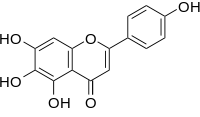Scutellaria barbata
| Scutellaria barbata | |
|---|---|
| Scientific classification | |
| Kingdom: | Plantae |
| (unranked): | Angiosperms |
| (unranked): | Eudicots |
| (unranked): | Asterids |
| Order: | Lamiales |
| Family: | Lamiaceae |
| Genus: | Scutellaria |
| Species: | S. barbata |
| Binomial name | |
| Scutellaria barbata D.Don. | |
Scutellaria barbata, the barbed skullcap,[1] is a species of flowering plant in the mint family, Lamiaceae. It is native to Asia.[2]
It is a perennial herb generally reaching up to 35 centimeters tall, sometimes taller. The lightly toothed leaves are somewhat lance-shaped or triangular and up to about 3 centimeters long. The flowers are borne on pedicels that have tiny, sharp bracteoles. The purple-blue, lightly hairy flower corolla is roughly a centimeter long. The plant grows in moist and wet habitat, such as paddy fields.[2]
As an herb used in traditional Chinese medicine it is known as Ban Zhi Lian (Chinese: 半枝莲; pinyin: bànzhīlián). It has been tested in clinical trials for the treatment of metastatic breast cancer.[3] Extracts induced apoptosis in prostate cancer cells in laboratory studies.[4] The plant is used as an herbal remedy for inflammation and traumatic injury.[2]
Gallery
 Scutellarein or 6-hydroxyapigenin a selected constituent of scullcap[5]
Scutellarein or 6-hydroxyapigenin a selected constituent of scullcap[5]
 limonene a selected constituent of scullcap.
limonene a selected constituent of scullcap.-%CE%B1-terpineol.svg.png) (+)-α-terpineol a selected constituents of scullcap.
(+)-α-terpineol a selected constituents of scullcap. β-cadinene a selected constituent of scullcap.
β-cadinene a selected constituent of scullcap. β-caryophyllene a selected constituent of scullcap.
β-caryophyllene a selected constituent of scullcap.
References
- ↑ Scutellaria barbata. Germplasm Resources Information Network (GRIN).
- 1 2 3 Scutellaria barbata. Flora of China.
- ↑ Carr, C. Can Ancient Herbs Treat Cancer? Time October 15, 2007.
- ↑ Wong, B. Y., et al. (2009). Chinese medicinal herb Scutellaria barbata modulates apoptosis and cell survival in murine and human prostate cancer cells and tumor development in TRAMP mice. European Journal of Cancer Prevention 18(4), 331-41.
- ↑ Tomimori, T; Jin, H; Miyaichi, Y; Toyofuku, S; Namba, T (Feb 1985). "[Studies on the constituents of Scutellaria species. VI. On the flavonoid constituents of the root of Scutellaria baicalensis Georgi (5). Quantitative analysis of flavonoids in Scutellaria roots by high-performance liquid chromatography].". Yakugaku Zasshi. 105 (2): 148–55. PMID 4009423.
- ↑ Phillipson, Carol A. Newall ; Linda A. Anderson ; J. David (1996). Herbal medicines : a guide for health care professionals (Reprinted. ed.). London: Pharmaceutical Press. p. 296. ISBN 0853692890.